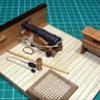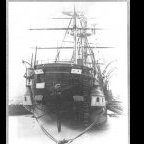Supplies of the Ship Modeler's Handbook are running out. Get your copy NOW before they are gone! Click on photo to order.
×
-
Posts
5,866 -
Joined
-
Last visited
Reputation Activity
-
 BANYAN reacted to davyboy in tying ratline to mast
BANYAN reacted to davyboy in tying ratline to mast
Hi David,
Skip what is in the instructions and make them as I wrote as that is the correct method. It's also easier and neater,you would have 8 loops to make taking more space on the masthead.
I do my shroud siezing like Pat says around a suitable sized dowel. I thread a needle with the siezing line and pass it through one of the legs at the top then take around ten turns downwards about both legs. I then pass the thread between the legs at one end of the siezing then over the siezing and through between the other legs doing so 2 or 3 times. Finally pass the needle & thread through the middle of that,apply some glue (not CA) when dry clip off. You're then good to go. This last bit sounds complicated but is dead easy to do.
Dave
-
 BANYAN got a reaction from KingDavid in tying ratline to mast
BANYAN got a reaction from KingDavid in tying ratline to mast
If an uneven set of shrouds (say 5 shrouds per side - 2 pairs and a single) the last leg (sometimes called a Swifter) had an eye or Cont splice in the middle of the length, which is sufficient to be passed around the deadeye either side and seized back on itself), with the eye passed over the masthead. The first /leading leg of each shroud set was usually served all the way down to minimize wear-and-tare from the sails/bolt ropes rubbing on them. The pairs were rigged as described by Dave.
So, for this example, you would have two pairs of shrouds per side, each pair would have been doubled and throat seized around the mast head, a single leg with the Cont splice (middled) was passed over the mashead as the after shroud legs. The ratlin' was then applied depending on the period in which the ship was built.
To get a good fit for the seizing/loop, to keep the seizing close to the masthead, use an off cut of the same diameter dowel placed in a piece of scrap to tie them off the model, then fit the pairs etc in the correct sequence as described by Dave. There are some good tips and videos available in this forum / You Tube etc to show how to do seizings (if you need them).
cheers
Pat
-
 BANYAN got a reaction from Matrim in tying ratline to mast
BANYAN got a reaction from Matrim in tying ratline to mast
If an uneven set of shrouds (say 5 shrouds per side - 2 pairs and a single) the last leg (sometimes called a Swifter) had an eye or Cont splice in the middle of the length, which is sufficient to be passed around the deadeye either side and seized back on itself), with the eye passed over the masthead. The first /leading leg of each shroud set was usually served all the way down to minimize wear-and-tare from the sails/bolt ropes rubbing on them. The pairs were rigged as described by Dave.
So, for this example, you would have two pairs of shrouds per side, each pair would have been doubled and throat seized around the mast head, a single leg with the Cont splice (middled) was passed over the mashead as the after shroud legs. The ratlin' was then applied depending on the period in which the ship was built.
To get a good fit for the seizing/loop, to keep the seizing close to the masthead, use an off cut of the same diameter dowel placed in a piece of scrap to tie them off the model, then fit the pairs etc in the correct sequence as described by Dave. There are some good tips and videos available in this forum / You Tube etc to show how to do seizings (if you need them).
cheers
Pat
-
 BANYAN got a reaction from mtaylor in tying ratline to mast
BANYAN got a reaction from mtaylor in tying ratline to mast
If an uneven set of shrouds (say 5 shrouds per side - 2 pairs and a single) the last leg (sometimes called a Swifter) had an eye or Cont splice in the middle of the length, which is sufficient to be passed around the deadeye either side and seized back on itself), with the eye passed over the masthead. The first /leading leg of each shroud set was usually served all the way down to minimize wear-and-tare from the sails/bolt ropes rubbing on them. The pairs were rigged as described by Dave.
So, for this example, you would have two pairs of shrouds per side, each pair would have been doubled and throat seized around the mast head, a single leg with the Cont splice (middled) was passed over the mashead as the after shroud legs. The ratlin' was then applied depending on the period in which the ship was built.
To get a good fit for the seizing/loop, to keep the seizing close to the masthead, use an off cut of the same diameter dowel placed in a piece of scrap to tie them off the model, then fit the pairs etc in the correct sequence as described by Dave. There are some good tips and videos available in this forum / You Tube etc to show how to do seizings (if you need them).
cheers
Pat
-
 BANYAN got a reaction from mtaylor in Help with soldering
BANYAN got a reaction from mtaylor in Help with soldering
HI Kevin,
Sorry for the delay but the time zones interfere with quick communications; not that it will make much difference as you have realised (due to closures etc).
For the same reasons, cost of transport etc, I put together a package I thought I would need. The following are my experiences BUT it all depends on how much you use the unit, and for what purposes. I mostly use it for smaller jobs and use a small torch (hand held) for bigger (not real big) jobs. I have built a special soldering jig for my purposes which comprises a 6 x 4 inch soldering pad (with holes) and a GRS single arm articulated arm and some special hold down fingers (based on the Gerald Wingrove rig).
Firstly, I must say that the guys at American Beauty were very helpful in putting together my kit, and also for the one small issue I had. The LED in the on/off switch stopped working, but the unit itself was still functional. I am not an agent etc just a very happy user. Our power supply is 240V which required them to put together a unit that also met our Certifications Standards - no problem for them at all. I opted for the Super Chief kit as the power/resistence range is ideal for our needs; even then I mostly operate with the lowest settings. I have even been able to control the soldering power to the point of safely soldering Photo Etched (PE) parts..
I ordered the unit with the tongs (came as a package - Super Chief) but I rarely use the tongs. I also ordered the hands free vise (product #105V12) - not sure they still sell it as it did not come up in a quick search I did. The truth is I rarely use it as I can do most jobs with a special set of leads I had made up that include an alligator clip on one lead and a single probe on the other. I had two sets done, one with the normal size aligator clip and another with a micro clip (be sure to ask for one with good gripping power/capacity as the small one I ordered initially had no grip at all . Also, be sure to order some additional probes.
For those in Australia, "COLTRONICS" (ask for James) in Sydney is the Aussie Agent - very helpful. No association etc, just a happy customer of these products.
cheers
Pat
-
 BANYAN reacted to Gerhardvienna in USS CAIRO by Gerhardvienna - RADIO - live steam
BANYAN reacted to Gerhardvienna in USS CAIRO by Gerhardvienna - RADIO - live steam
Hi Friends!!
Nice to have such a welcome back!! Next thing to do for me is to save all my pics from this thread back to my PC, and then have a new restart. Fortunatly I "save" most of my pictures in the building reports, so I can have a good base for the build. CU soon with new pics, when the "old things" are saved!
Best regards
Gerhard
-

-
 BANYAN got a reaction from Bob Cleek in Help with soldering
BANYAN got a reaction from Bob Cleek in Help with soldering
Hi Kevin, I am a real fan of resistance soldering and I use the Super Chief unit you showed in the video.
By dialing down the power/resistance, I am able to achieve some very small soldered joints even close to each other; although, if you can use a heat sink that is better. To do this the most important thing, as with any soldering type, is to develop/use a jig that will hold the items in place while you make the joint. Also, a 'clean' tight joint always works best, but I have managed to gap fill using this method.
My preferred method is to put a dab of 'NoKarode' flux between and around the joint and place a small pellet (small piece cut from the wire) of solder on the opposite side of the joint so it flows towards the heat source. I have found that sometimes depending where you place the points of the rod/clip affects this, so sometimes I need to reverse the leads to the unit. I prefer to use a lead with an alligator/crocodile clip on one side as that frees your hands and provides a good contact - American Beauty can make these up for you. I use the single probe lead to then place the point at which I wish to supply heat. For joints closer together I use different melt point solders, as for any other type of soldering.
As you can see from the attached, the small eyes and the lug at the base (shown on top) of this bowsprit cap I am assembling, are quite close together and I was able to achieve this with no heat sinks, including soldering the side plates. The piece is still being completed and a bit of clean-up still required. I prefer to use silver solder for its strength and variety of melting points even if there is no real pressure being applied to the joints. I stay away from the premix silver solders and cored rosin solders as I find they leave too much residue which affects the blackening process (even if I pickle) but if you are painting this should not be a problem and will widen the range of melting points for you.
I hope this helps?
cheers
Pat
-
 BANYAN got a reaction from Ryland Craze in Help with soldering
BANYAN got a reaction from Ryland Craze in Help with soldering
Hi Kevin, I am a real fan of resistance soldering and I use the Super Chief unit you showed in the video.
By dialing down the power/resistance, I am able to achieve some very small soldered joints even close to each other; although, if you can use a heat sink that is better. To do this the most important thing, as with any soldering type, is to develop/use a jig that will hold the items in place while you make the joint. Also, a 'clean' tight joint always works best, but I have managed to gap fill using this method.
My preferred method is to put a dab of 'NoKarode' flux between and around the joint and place a small pellet (small piece cut from the wire) of solder on the opposite side of the joint so it flows towards the heat source. I have found that sometimes depending where you place the points of the rod/clip affects this, so sometimes I need to reverse the leads to the unit. I prefer to use a lead with an alligator/crocodile clip on one side as that frees your hands and provides a good contact - American Beauty can make these up for you. I use the single probe lead to then place the point at which I wish to supply heat. For joints closer together I use different melt point solders, as for any other type of soldering.
As you can see from the attached, the small eyes and the lug at the base (shown on top) of this bowsprit cap I am assembling, are quite close together and I was able to achieve this with no heat sinks, including soldering the side plates. The piece is still being completed and a bit of clean-up still required. I prefer to use silver solder for its strength and variety of melting points even if there is no real pressure being applied to the joints. I stay away from the premix silver solders and cored rosin solders as I find they leave too much residue which affects the blackening process (even if I pickle) but if you are painting this should not be a problem and will widen the range of melting points for you.
I hope this helps?
cheers
Pat
-
 BANYAN got a reaction from mtaylor in Help with soldering
BANYAN got a reaction from mtaylor in Help with soldering
Hi Kevin, I am a real fan of resistance soldering and I use the Super Chief unit you showed in the video.
By dialing down the power/resistance, I am able to achieve some very small soldered joints even close to each other; although, if you can use a heat sink that is better. To do this the most important thing, as with any soldering type, is to develop/use a jig that will hold the items in place while you make the joint. Also, a 'clean' tight joint always works best, but I have managed to gap fill using this method.
My preferred method is to put a dab of 'NoKarode' flux between and around the joint and place a small pellet (small piece cut from the wire) of solder on the opposite side of the joint so it flows towards the heat source. I have found that sometimes depending where you place the points of the rod/clip affects this, so sometimes I need to reverse the leads to the unit. I prefer to use a lead with an alligator/crocodile clip on one side as that frees your hands and provides a good contact - American Beauty can make these up for you. I use the single probe lead to then place the point at which I wish to supply heat. For joints closer together I use different melt point solders, as for any other type of soldering.
As you can see from the attached, the small eyes and the lug at the base (shown on top) of this bowsprit cap I am assembling, are quite close together and I was able to achieve this with no heat sinks, including soldering the side plates. The piece is still being completed and a bit of clean-up still required. I prefer to use silver solder for its strength and variety of melting points even if there is no real pressure being applied to the joints. I stay away from the premix silver solders and cored rosin solders as I find they leave too much residue which affects the blackening process (even if I pickle) but if you are painting this should not be a problem and will widen the range of melting points for you.
I hope this helps?
cheers
Pat
-
 BANYAN got a reaction from KeithAug in Germania Nova 1911 by KeithAug - FINISHED - Scale 1:36 - replica of schooner Germania 1908
BANYAN got a reaction from KeithAug in Germania Nova 1911 by KeithAug - FINISHED - Scale 1:36 - replica of schooner Germania 1908
I hope you are able to recover your Company after this awful pandemic Hubert.
Thanks for explaining the detail and sequence Keith, makes sense once you explained it. Thanks to Eberhard for the additional comment; yes not intuitive but logical (starting to sound like a 'Vulcan' now; no pointy ears last time checked )
cheers
Pat
-
 BANYAN got a reaction from mtaylor in Germania Nova 1911 by KeithAug - FINISHED - Scale 1:36 - replica of schooner Germania 1908
BANYAN got a reaction from mtaylor in Germania Nova 1911 by KeithAug - FINISHED - Scale 1:36 - replica of schooner Germania 1908
I hope you are able to recover your Company after this awful pandemic Hubert.
Thanks for explaining the detail and sequence Keith, makes sense once you explained it. Thanks to Eberhard for the additional comment; yes not intuitive but logical (starting to sound like a 'Vulcan' now; no pointy ears last time checked )
cheers
Pat
-
 BANYAN got a reaction from Keith Black in Germania Nova 1911 by KeithAug - FINISHED - Scale 1:36 - replica of schooner Germania 1908
BANYAN got a reaction from Keith Black in Germania Nova 1911 by KeithAug - FINISHED - Scale 1:36 - replica of schooner Germania 1908
I hope you are able to recover your Company after this awful pandemic Hubert.
Thanks for explaining the detail and sequence Keith, makes sense once you explained it. Thanks to Eberhard for the additional comment; yes not intuitive but logical (starting to sound like a 'Vulcan' now; no pointy ears last time checked )
cheers
Pat
-
 BANYAN reacted to wefalck in Germania Nova 1911 by KeithAug - FINISHED - Scale 1:36 - replica of schooner Germania 1908
BANYAN reacted to wefalck in Germania Nova 1911 by KeithAug - FINISHED - Scale 1:36 - replica of schooner Germania 1908
Keith's fabricating sequence shows that sometimes one has to break down parts not into their 'logical' components, but rather into what can be machined and how. In reality the flange would be on the elbow, but turning the flange onto the straight part is the only way to go. This can be quite counterintuitive.
-
 BANYAN reacted to KeithAug in Germania Nova 1911 by KeithAug - FINISHED - Scale 1:36 - replica of schooner Germania 1908
BANYAN reacted to KeithAug in Germania Nova 1911 by KeithAug - FINISHED - Scale 1:36 - replica of schooner Germania 1908
Thank you for your comments Eberhard. I agree small bits do take a disproportionate amount of time and eyestrain is a limiting factor. I must get more practiced in wearing a magnifying visor, to date i have always failed to master the technique.
Yes Richard modelling can become a bit obsessive.
Pat - actually no filing involved - the following should explain:-
I first turned the diameters "A" on the rod to the upper right.
I then soldered on the elbow at point "B".
I then cut off the the upper right rod at point "C".
I then held the elbow in the lathe chuck using the shaft at "D".
Then I turned a diameter at "E" using a parting tool. This formed the spigot diameter "F".
I then parted off the elbow from the shaft.
The flange was then turned and fitted on the spigot.
-
 BANYAN reacted to DORIS in HMS ROYAL KATHERINE 1664 by Doris - 1/55 - CARD
BANYAN reacted to DORIS in HMS ROYAL KATHERINE 1664 by Doris - 1/55 - CARD
And finally I have added required ropes - the spans on gunports lids on lower and middle deck. The upper ones will be completed later.
-
 BANYAN reacted to DORIS in HMS ROYAL KATHERINE 1664 by Doris - 1/55 - CARD
BANYAN reacted to DORIS in HMS ROYAL KATHERINE 1664 by Doris - 1/55 - CARD
Fully armed Royal Katherine is now carrying 88 cannons.
-
 BANYAN reacted to James H in Lady Isabella by James H - FINISHED - Vanguard Models - 1:64 - Zulu prototype
BANYAN reacted to James H in Lady Isabella by James H - FINISHED - Vanguard Models - 1:64 - Zulu prototype
Maybe I should do a small update.
I've had time to do some planking during my enforced isolation. Here you see the hull with the pear bulwarks installed. Underneath that is a lime wood plank with a naturally guessed taper. PVA is used for these, and my trusty Amati nail pusher.
Limewood planks are now fitted and tapered where the natural lie of the planks overlaps the previous. That bow sure looks ugly with those over length planks. That will now be cut back and tidied up.
With the bow tidied up, the stem keel section is finally glue into place. This fits like a dream with no ambiguity.
The pear wood keel is to be lined with an external layer, creating the rabbet that the second layer planks will fit into. Before this though, the key parts are fitted.
Those keel facing parts are now added...
Here you see how the rudder sockets are created with the keel face parts.
Now, the garboard planks are pre-cut. This is to help the modeller with the curvature at both bow and stern. These are an excellent fit. To start, I dry fit the stern side garboard plank. When I have achieved a good fit, I make a couple of pencil marks to absolutely determine its position. The plank is then removed and Gorilla Glue CA Gel is applied to it and the plank slipped into the keel rebate before being shaped into the stern curve.
There same now applies to the stem garboard plank. This is the result.
More soon!
-
 BANYAN got a reaction from Kikatinalong in 10th-11th century Byzantine dromon by Louie da fly - FINISHED - 1:50
BANYAN got a reaction from Kikatinalong in 10th-11th century Byzantine dromon by Louie da fly - FINISHED - 1:50
That should work well Steven. Now to set up the production line
For those whom may have been concerned of my offer to Steven in these troubling times, I am self-isolating as best as we can and make such offers very judiciously (only to people whom we know well enough to feel comfortable will have taken every precaution and would not travel if there is even the slightest hint of being unwell).
cheers
Pat
-
 BANYAN got a reaction from EJ_L in 10th-11th century Byzantine dromon by Louie da fly - FINISHED - 1:50
BANYAN got a reaction from EJ_L in 10th-11th century Byzantine dromon by Louie da fly - FINISHED - 1:50
That should work well Steven. Now to set up the production line
For those whom may have been concerned of my offer to Steven in these troubling times, I am self-isolating as best as we can and make such offers very judiciously (only to people whom we know well enough to feel comfortable will have taken every precaution and would not travel if there is even the slightest hint of being unwell).
cheers
Pat
-
 BANYAN got a reaction from KeithAug in Germania Nova 1911 by KeithAug - FINISHED - Scale 1:36 - replica of schooner Germania 1908
BANYAN got a reaction from KeithAug in Germania Nova 1911 by KeithAug - FINISHED - Scale 1:36 - replica of schooner Germania 1908
Man-o-man you achieve some very nice detail into your metalwork. I am still trying to figure how you did those flanges on the elbow (a bit of file work I am assuming?)
Works of art Keith!
cheers
Pat
-
 BANYAN got a reaction from mtaylor in 10th-11th century Byzantine dromon by Louie da fly - FINISHED - 1:50
BANYAN got a reaction from mtaylor in 10th-11th century Byzantine dromon by Louie da fly - FINISHED - 1:50
That should work well Steven. Now to set up the production line
For those whom may have been concerned of my offer to Steven in these troubling times, I am self-isolating as best as we can and make such offers very judiciously (only to people whom we know well enough to feel comfortable will have taken every precaution and would not travel if there is even the slightest hint of being unwell).
cheers
Pat
-
 BANYAN got a reaction from mtaylor in Germania Nova 1911 by KeithAug - FINISHED - Scale 1:36 - replica of schooner Germania 1908
BANYAN got a reaction from mtaylor in Germania Nova 1911 by KeithAug - FINISHED - Scale 1:36 - replica of schooner Germania 1908
Man-o-man you achieve some very nice detail into your metalwork. I am still trying to figure how you did those flanges on the elbow (a bit of file work I am assuming?)
Works of art Keith!
cheers
Pat
-
 BANYAN got a reaction from Keith Black in Making extremely tiny fittings
BANYAN got a reaction from Keith Black in Making extremely tiny fittings
Thanks for sharing this Kurt, you have just given me the solution for making 'cheek blocks' for the yards and bowsprit of my model A small modification, drill a hole for the sheaves and not open the top, a bit of rounding with a file and hey presto.
cheers
Pat
-
 BANYAN got a reaction from mtaylor in Making extremely tiny fittings
BANYAN got a reaction from mtaylor in Making extremely tiny fittings
Thanks for sharing this Kurt, you have just given me the solution for making 'cheek blocks' for the yards and bowsprit of my model A small modification, drill a hole for the sheaves and not open the top, a bit of rounding with a file and hey presto.
cheers
Pat









